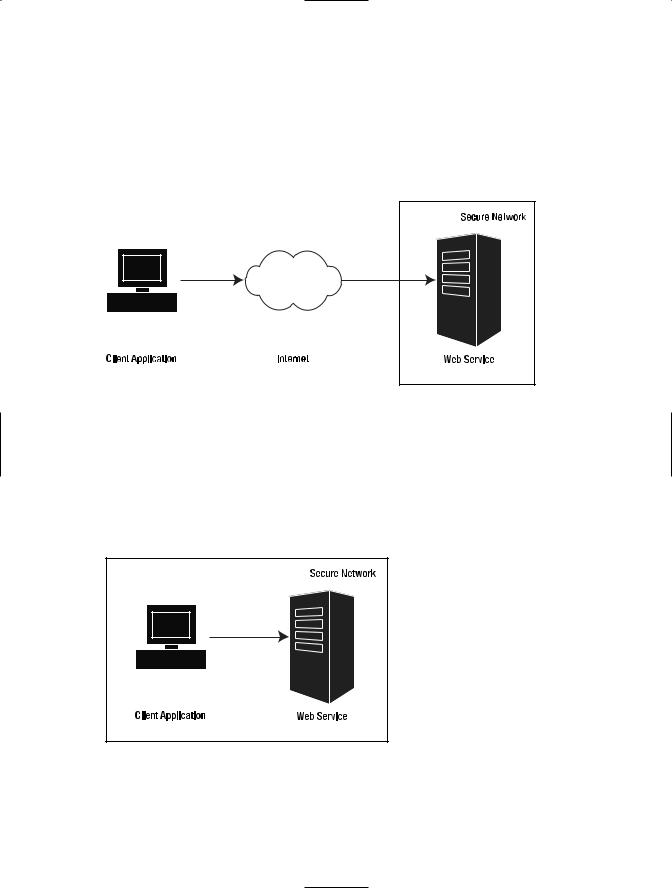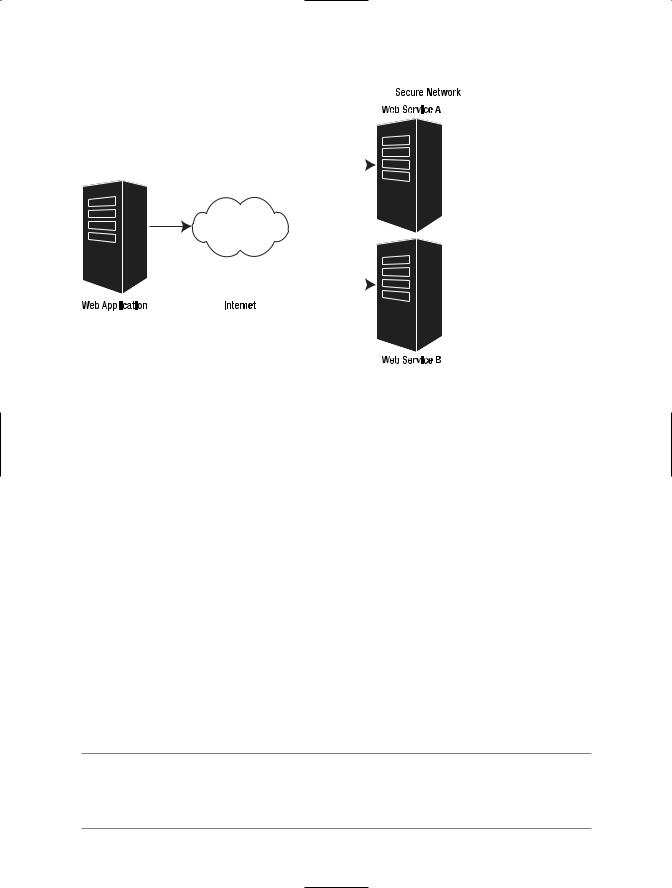
Expert Service-Oriented Architecture In CSharp 2005 (2006) [eng]
.pdf
106 C H A P T E R 5 ■ W E B S E R V I C E S E N H A N C E M E N T S 3 . 0
Final Thoughts on WSE
WSE is an evolving product that implements only a subset of the available ratified WSspecifications. Microsoft has done a good job of implementing the more popular WSspecifications, including security and policy. But the WSE product cannot keep pace with the rapid change of the WSspecifications. Existing specifications continue to change and new ones continue to be released. Even within a given specification, WSE will probably only cover a subset of what is available. This is in fact why Microsoft develops WSE on a separate release schedule from the
.NET Framework.
Summary
This chapter introduced you to the Web services specifications, or WSspecifications, which provide a framework for building secure, reliable, service-oriented Web services. The WSspecifications provide the following benefits when they are implemented in Web services:
•Interoperability
•Composability
•Security
•Description and discovery
•Messaging and delivery
•Transactions
Microsoft Web Services Enhancements 3.0 is a software developer kit for implementing the WSspecifications in .NET applications. It includes the Microsoft.Web.Services3 assembly, configuration tools, QuickStart application samples, and documentation. WSE is an excellent productivity tool that implements many of the important WSspecifications. The current version of WSE does have gaps, most notably in its support for transactions. Developers will need to build some aspects of the WSspecifications manually for now.
This chapter lays the groundwork for the rest of the book, which explores several of the WSspecifications in detail.

C H A P T E R 6
Secure Web Services with WS-Security
Companies have started the adoption of Web service technology and the WS-Security specification as an approach to ensure the integrity of transmitted messages and data. The WS-Security specification is a joint effort by Microsoft, IBM, and VeriSign to address this most important issue. The WS-Security specification is designed to provide an extensible security implementation that will evolve as Web services technology becomes more sophisticated.
The WS-Security Specification
What do we actually mean when we talk about security? In broad terms, we are talking about authentication, authorization, data integrity, and confidentiality.
Authentication: This is the process of identifying a user based on credentials. In SOA, the user is not necessarily a person; it can be an application that is making a remote call from the intranet or Internet. This application must be able to identify itself by providing the required credentials. These credentials can be in the form of a username and password, also known as Username Token, or a digital certificate, such as an X.509 certificate or a Kerberos token.
Authorization: This is the process of validating whether an already authenticated user has access to a particular resource. For example, a Web service can perform multiple operations and they might only be available to a limited group of users or roles. Together, authentication and authorization provide a security model that allows you to identify users and then give them selective access to resources.
Integrity: This means that the message was not tampered during transit. A digitally signed message helps us ensure that the content of a message hasn’t been modified before reaching its destination. Digital signatures work by generating a short string based on the content of the message. This short string or hash is most likely unique, and a single change made to the content of the message would generate a different hash value.
107

108 C H A P T E R 6 ■ S E C U R E W E B S E R V I C E S W I T H W S - S E C U R I T Y
Confidentiality: This is the process that guarantees that only authorized individuals have access to a message. In order to protect a message, its contents must be encrypted. An encrypted message would not be readable by intruders that do not possess the key to decrypt the message. There are two types of encryption: symmetric and asymmetric.
•Symmetric encryption: In this scenario the client and the service use the same key to encrypt and decrypt the message.
•Asymmetric encryption: In this scenario one party encrypts the message using one key and the other party decrypts it using a different key. This is also known as
public key encryption. These two keys are also known as the public/private key pair. The public key is available to anyone who wants to communicate with the service, and the client uses this key to encrypt the messages. The private key is used by the service to decrypt the messages encrypted with the public key.
The prime currency in SOA applications is SOAP messages, because they are the means by which requests are made and responses are received from Web service methods. The WS-Security specification provides a way for you to protect the integrity and confidentiality of messages and to implement authentication and authorization models in your Web services. The WS-Security specification enables you to implement the following protections in your Web service calls:
Authentication: Security credentials, or tokens, may be exchanged between a client and a Web service to validate the identity of the caller. The tokens are added directly to the header of the SOAP message.
Digital signing: Digital signing creates a cryptographic signature attached to the message that uniquely identifies the sender. The receiver can check this signature to verify the identity of the sender and the integrity of the message. A SOAP exception is raised on the receiving end if the contents of a SOAP message have been tampered with. Digital signing is especially important in an SOA where a single SOAP message may be routed through multiple SOAP endpoints and across multiple servers. Message integrity is essential in any Web service–based architecture, but especially in an SOA.
Encryption: This encodes a SOAP message to ensure its confidentiality. A number of available encryption algorithms are available. In addition, you can encrypt a SOAP message based on an X.509 certificate.
The goal of this specification is to provide mechanisms that will enable businesses to exchange SOAP messages in a secure environment. The specification does not intend to replace previous security specifications; on the contrary, it leverages existing security standards such as SSL, X.509, and Kerberos.
The WS-Security specification is platform-independent and transport-neutral, as are all of the other WSspecifications. Security information is generated by the client and stored within the envelope of the SOAP request message. The Web service in turn will deserialize this information; verify its validity, and then process the requested operation. In the event that the message security does not pass verification, the Web service will return a SOAP fault back to the client.

C H A P T E R 6 ■ S E C U R E W E B S E R V I C E S W I T H W S - S E C U R I T Y |
109 |
Listings 6-1 and 6-2 compare two SOAP request messages for the same Web service method. The Web service is StockTrader.asmx, and the requested method is RequestQuote, which accepts a single stock ticker symbol as an input parameter. Listing 6-1 is an unsecured Web method call, while Listing 6-2 is secured and implements digital signing and encryption (based on an X.509 certificate). The listings are greatly simplified for clarity and for length and were originally created using the trace files generated by WSE 3.0.
Listing 6-1. Unsecured SOAP Request Message (Simplified for Clarity)
<soap:Envelope>
<soap:Header>
<wsa:Action>
http://www.bluestonepartners.com/schemas/StockTrader/RequestQuote
</wsa:Action>
<wsa:MessageID>Message ID</wsa:MessageID> <wsa:ReplyTo>
<wsa:Address>
http://schemas.xmlsoap.org/ws/2004/08/addressing/role/anonymous
</wsa:Address>
</wsa:ReplyTo>
<wsa:To>
http://localhost/StockTraderContracts/StockTrader.asmx
</wsa:To>
<wsse:Security>
<wsu:Timestamp>
Message Creation/Expiration TimeStamps
</wsu:Timestamp>
</wsse:Security>
</soap:Header>
<soap:Body>
<Symbol> MSFT </Symbol>
</soap:Body>
</soap:Envelope>
Listing 6-2. Digitally Signed and Encypted SOAP Message with Highlighted Differences from an Unsigned SOAP Message (Simplified for Clarity)
<soap:Envelope>
<soap:Header>
<wsa:Action>
http://www.bluestonepartners.com/schemas/StockTrader /RequestQuote

110 C H A P T E R 6 ■ S E C U R E W E B S E R V I C E S W I T H W S - S E C U R I T Y
</wsa:Action>
<wsa:MessageID>
Message ID
</wsa:MessageID>
<wsa:ReplyTo>
<wsa:Address>
http://schemas.xmlsoap.org/ws/2004/08/addressing/role/anonymous
</wsa:Address>
</wsa:ReplyTo>
<wsa:To>
http://localhost/StockTraderContracts/StockTrader.asmx
</wsa:To>
<wsse:Security soap:mustUnderstand="1"> <wsu:Timestamp>
Contains Message Creation/Expiration TimeStamps
</wsu:Timestamp>
<wsse:BinarySecurityToken>
Represents an X.509 security token
</wsse:BinarySecurityToken>
<xenc:EncryptedKey>
<xenc:EncryptionMethod>
Specifies the algorithm that is used to encrypt a SOAP message
</xenc:EncryptionMethod>
<xenc:CipherData>
<xenc:CipherValue>Encrypted key</xenc:CipherValue> </xenc:CipherData>
</xenc:EncryptedKey>
<wssc:DerivedKeyToken>
Represents a security token whose key is cryptographically derived from the key of another security token
</wssc:DerivedKeyToken>
<Signature>
Represents the name of the element that defines a signature
</Signature>
</wsse:Security>
</soap:Header>
<soap:Body>
<xenc:EncryptedData > <xenc:EncryptionMethod/> <KeyInfo>
<wsse:SecurityTokenReference>
<wsse:Reference/>
</wsse:SecurityTokenReference>
</KeyInfo>
<xenc:CipherData>
<xenc:CipherValue>

C H A P T E R 6 ■ S E C U R E W E B S E R V I C E S W I T H W S - S E C U R I T Y |
111 |
Encrypted message body
</xenc:CipherValue>
</xenc:CipherData>
</xenc:EncryptedData>
</soap:Body>
</soap:Envelope>
The main difference between Listing 6-1 and Listing 6-2 is the addition of WS-Security tags in the request header and an encrypted message body. You can notice that the value of the symbol parameter is not readable in Listing 6-2.
This is a clear example of Web service composability, where additional specifications may be added or subtracted to a SOAP message as needed. WSE provides the API for implementing WS-Security in .NET-based Web services and client applications. The API allows you to write code to format secured SOAP request messages in the client and to process secured messages within a Web service.
Secure Web Services in an SOA
Security in an SOA presents several challenges. Traditional security mechanisms do not provide a comprehensive solution because most of them depend on a well-defined boundary that limits the enforcements of their rules. Plus, our industry has been shaped by companies that have developed products that do not necessarily integrate well with each other or that do not integrate at all. If we add the fact that hacker attacks occur on a daily basis, and that they could even come from someone within your organization, we have a not-so-pleasant picture that requires well-designed security strategies.
Before we look at some of these strategies, let’s review the most important challenges involved in securing an SOA:
Interoperability and policies: There are several encryption and signing mechanisms and there are several platforms with different security models. A service and their consumers need to be able to implement the same standard in order to establish a successful communication.
Message security: A SOAP message crosses domain boundaries, and it might go through intermediaries. Traditional security models are designed to work within a controlled environment, but in the case of SOA there are messages that will be transmitted across multiple environments, and the integrity and confidentiality of the message still needs to be guaranteed.
Identity and trust: Both the client and the server need to know that they can rely on the other party. Each one of the systems that consume or expose a Web service might be under a different security model, and users will still need to be authenticated and authorized to perform a particular task.
WSE 3.0 provides us with the tools required to address most of these concerns without having to manually build the messages that will be compliant with the WS-Security specification. You might be thinking that all you need to secure your services is to enable SSL on your

112C H A P T E R 6 ■ S E C U R E W E B S E R V I C E S W I T H W S - S E C U R I T Y
web application, but that is only the tip of the iceberg when it comes to a robust security implementation. There are several disadvantages of securing communication at the transport level and it will not always be the best option for your particular needs.
■Note Transport level security is the term used when data protection is provided by securing the communication channel itself. The most common example is the HTTPS channel that secures connections between browsers and web servers. HTTPS is based on the SSL protocol.
Existing security technologies, such as SSL, have limitations. We will address this particular topic in this chapter because it will help you understand why the WSE toolkit plays such an important role in the development of a secure Web service. These limitations are in the following areas:
Point-to-point security: SSL does not allow your message to go through intermediaries that might need to read the message or parts of the message and then forward it to a third-party entity.
Wire protection: Messages are only protected while they are on the wire. If the message reaches its destination and it gets stored it will be saved as plain text. This means that the message could be accessible to unauthorized users if the application is not properly configured to guarantee the message confidentiality.
Transport level encryption: You can’t encrypt only a fragment of a message when you use transport level encryption. This is limiting because there are some cases where not all the information in the message needs to be protected, and you could reduce some of the encryption/decryption overhead by encrypting only the message elements that are confidential.
The WSE toolkit provides a solution for each one of these restrictions. Let’s take a closer look at WSE 3.0 to see how it can be used to build a secure Web service based on the needs of your deployment scenario.
Implement WS-Security Using the WSE 3.0 Toolkit
One of the main design goals behind WSE 3.0 was to create a better product that allowed software developers to easily build secure Web services. The feedback obtained after releasing WSE 1.0 and 2.0 allowed the identification of common security scenarios.
You can find that your problem at hand is similar but not identical to one of these security scenarios. If that is the case, you can still leverage the portion of the scenario that matches your particular needs.

C H A P T E R 6 ■ S E C U R E W E B S E R V I C E S W I T H W S - S E C U R I T Y |
113 |
Public Web service: An application accesses a Web service provided by a third party. In this scenario the users are authenticated by sending a username and a password to the Web service. The Web service decrypts this data and validates it against a local identity store. The information that is transmitted needs to be protected, so the client and the server communicate using HTTPS. The service is accessed via the Internet, as shown in Figure 6-1.
Figure 6-1. A public Web service
Intranet Web service: An organization exposes a Web service that provides business operations. In this scenario the messages are always within the boundaries of an organization that uses Active Directory to manage the network security. Active Directory supports the Kerberos protocol which provides the authentication, encryption, and message signing mechanisms required to guarantee a secure communication. This Web service is accessed by internal applications through the intranet, as shown in Figure 6-2.
Figure 6-2. An intranet Web service

114 C H A P T E R 6 ■ S E C U R E W E B S E R V I C E S W I T H W S - S E C U R I T Y
Internet B2B: Messages flow within an organization and between businesses. This scenario requires two different solutions: one for the client application that communicates with the internal Web service, and another one to secure the communication between two Web services that are hosted by different organizations. For the internal communication, the chosen solution is implemented using the Kerberos protocol. For the communication between businesses, X.509 certificates are used to provide mutual authentication, data protection, and data authenticity. Figure 6-3 shows a Web service that uses one security protocol for messages that are sent within the organization, and a different one for messages that are transferred between businesses.
Figure 6-3. A B2B Web service |
Multiple Internet Web services: These services are exposed by organizations whose policies require single sign-on capabilities (SSO). In this scenario the web application needs to access several services provided by an organization that stores user credentials in a database. The web application uses a secure channel to communicate with a Security Token Service (STS) that generates a secure token. This secure token can be used to interact with Web services A and B. This model provides a performance benefit because the authentication of the user is done only once: at the beginning of the session. The rest of the service calls are done using the secure token provided by the STS. Figure 6-4 illustrates a highly utilized web application that needs to access more than one external service.
These common security scenarios helped Microsoft define a set of core strategies that allow software developers to easily secure a Web service. These strategies are called turnkey security assertions and they are available in WSE 3.0 as a group of predefined policies that can be configured using the WSE 3.0 Settings Tool, or manually via code or a configuration file. Before we discuss these turnkey assertions, let’s review the policy framework provided by WSE. This will help you understand the way that messages get processed when they are being sent or received by a client or a service.

C H A P T E R 6 ■ S E C U R E W E B S E R V I C E S W I T H W S - S E C U R I T Y |
115 |
|||
|
|
|
|
|
|
|
|
|
|
|
|
|
|
|
|
|
|
|
|
Figure 6-4. A multiple Internet Web service
WSE 3.0 Security Policies
WSE provides a set of classes that allow you to define your security requirements by declaring a policy using an XML configuration file. This file can be edited manually or using the WSE Settings Tool. Later in this chapter you will have the opportunity to use this tool to implement security policies for a client and service project. Each policy file can contain multiple policies, which gives you the flexibility to enforce different security restrictions within the same application.
You can also define your policies directly in the code. This could be a good option if you don’t want to have the flexibility to add the policy definition without having to recompile your application. We recommend using policy files, since they will give system administrators the ability to modify the policy depending on the characteristics of the deployment environment. If you separate the security policy from the code you will increase the maintainability of your system and it will make your application easier to secure.
A policy is a group of policy assertions that map directly to a class. These classes get instantiated at runtime by the WSE framework and they are responsible for processing the SOAP messages and applying digital signatures, encryption, or any other custom processing that you might need, such as writing the content of the message to trace log.
■Note WSE 3.0 has greatly simplified the policy model, compared to the one provided by WSE 2.0. In this new version of WSE, the declarative model and the imperative programming model have been aligned so that you can use policy files to implement the same security restrictions that you could define via code.
